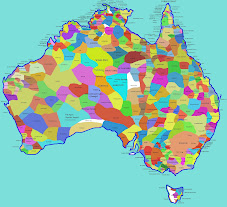For the Yolngu people, culture is a manifestation of their ties to the land and the supernatural world that resides there. The focus of the spiritual life of the Aboriginal people is “The Dreaming”, a reality beyond the everyday world, a reality that brings moral order to the cosmos. Through stories of supernatural beings and ancestors that lived long ago, the Aboriginal peoples learn how the laws of social and religious behavior came about and, more importantly, how to maintain harmony between humans and the natural universe.
The stories of the Dreaming are sometimes widespread but more often regional and even residing in individual families. Individuals often inherit rights to depict specific Dreaming stories and thereby to communicate the religious meaning of those stories to the world at large. With the subjugation of the Aboriginal peoples by European colonizers beginning in 1788 and the recent rejuvenation of Aboriginal culture and civil rights, there has been a resurgence of pride and interest in the stories of the Dreaming. The Yolngu people, in their art, music, and dance have been prominent in this Aboriginal cultural renaissance.
There is evidence of rock paintings in Arnhem Land from as early as 50,000 years ago. But bark painting, using the bark of eucalyptus trees, has been more prominent in Yolngu art in the last 200 years and, in particular, among contemporary artists keeping the ancient tradition alive. David Malangi, perhaps the best known of Yolngu bark painters, has devoted much of his work to the story of Gunmurringgu, The Great Hunter. Gunmurrungu camped under a tree after killing a kangaroo and then was bitten and killed by a giant snake. Malangi’s paintings depict the death of the Great Hunter and the funeral rites that followed, including the reburial ceremony, when the bones are placed in a log coffin. Here are examples of his Gunmuringgu paintings (Click on the links for further information about the paintings):

http://nga.gov.au/Exhibition/malangi/Detail.cfm?IRN=127710&BioArtistIRN=14101&MnuID=1

http://nga.gov.au/Exhibition/malangi/Detail.cfm?IRN=68078&BioArtistIRN=14101&MnuID=1
In 1988, when Australians celebrated 200 years of European settlement, Yolngu artists seized the opportunity to present a response from all Aboriginal peoples. The result was "The Aboriginal Memorial," a collection of 200 hollow log coffins, one for each year of European settlement. The coffins are painted with the designs and Dreamings of the individual artists. The exhibit, now residing at the National Gallery of Australia in Canberra, is a strong statement by Aboriginal artists that their stories, values and perspectives are relevant to the non-Aboriginal world. Here is a link to the exhibit:
http://nga.gov.au/AboriginalMemorial/home.cfm
Here is a panoramic view of the exhibit (mouse on the picture to move around the room):
http://nga.gov.au/panos/SML.cfm?MOV=MemPoles/Poles
Yolngu music also has a long tradition and, as for Yolngu art, has taken up the challenge of responding to threats to that tradition by contemporary Western culture. Yothu Yindi, the most famous Aboriginal band, hails from Arnhem Land and sings in a mixture of English and Yolngu. Its name means “child and mother” and its home web site states that one of its main goals is the “building of bridges between the cultures that share this land.” Yothu Yindi’s songs and videos both showcase traditional music and protest exploitation of Aboriginal peoples. “Treaty” is a demand that a promised treaty between the Australian government and Aboriginal peoples not be delayed (“words are easy, words are cheap. . . treaty now!”):
http://www.youtube.com/watch?v=S7cbkxn4G8U&feature=related
Djapana (Sunset Dreaming) is a tribute to Yolngu values (“don’t be fooled by the Balanda [white man’s] ways”):
http://www.youtube.com/watch?v=CG-CNqOhO2c&feature=related
In addition to its musical endeavors, Yothu Yindi helped found the Yothu Yindi Foundation, an organization which promotes Yolngu culture and sponsors the annual Garma festival in Arnhem Land, in 1990.
When we think of Aboriginal music, we think of the didgeridoo, which the Yolngu call the yidaki.

The yidaki orginated in Yolngu land and, according to the Garma Festival web site, “the Yolngu people have long recognized the healing powers of the yidaki. Sound transfers peaceful vibrations that penetrate the mind and create inner spiritual oneness in an individual or group.” To play the yidaki or didgeridoo, one must learn circular breathing. Here’s how it’s done:
http://www.youtube.com/watch?v=UmS7RlcIAqU










